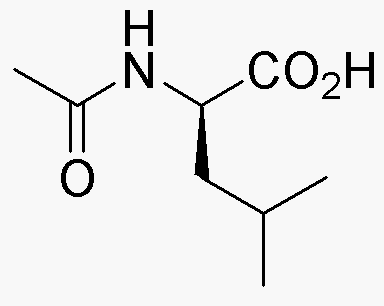Acetyl-D-leucine is widely utilized in research focused on:
- Neurological Research: This compound is studied for its potential neuroprotective effects, particularly in conditions like Alzheimer's disease, where it may help in reducing cognitive decline.
- Pharmaceutical Development: Used as a building block in the synthesis of pharmaceuticals, it aids in the development of drugs targeting metabolic disorders.
- Sports Medicine: Athletes and trainers explore its benefits for muscle recovery and performance enhancement, as it may assist in protein synthesis.
- Biochemical Studies: Researchers utilize it in studies of amino acid metabolism, helping to understand its role in various biochemical pathways.
- Dietary Supplements: It is incorporated into nutritional products aimed at improving muscle mass and overall health, appealing to fitness enthusiasts.
Información general
Propiedades
Seguridad y normativas
Aplicaciones
Acetyl-D-leucine is widely utilized in research focused on:
- Neurological Research: This compound is studied for its potential neuroprotective effects, particularly in conditions like Alzheimer's disease, where it may help in reducing cognitive decline.
- Pharmaceutical Development: Used as a building block in the synthesis of pharmaceuticals, it aids in the development of drugs targeting metabolic disorders.
- Sports Medicine: Athletes and trainers explore its benefits for muscle recovery and performance enhancement, as it may assist in protein synthesis.
- Biochemical Studies: Researchers utilize it in studies of amino acid metabolism, helping to understand its role in various biochemical pathways.
- Dietary Supplements: It is incorporated into nutritional products aimed at improving muscle mass and overall health, appealing to fitness enthusiasts.
Documentos
Hojas de datos de seguridad (HDS)
La SDS proporciona información de seguridad completa sobre la manipulación, el almacenamiento y la eliminación del producto.
Especificación del producto (PS)
La PS proporciona un desglose completo de las propiedades del producto, incluida la composición química, el estado físico, la pureza y los requisitos de almacenamiento. También detalla los rangos de calidad aceptables y las aplicaciones previstas del producto.
Certificados de análisis (COA)
Busque certificados de análisis (COA) ingresando el número de lote del producto. Los números de lote y de partida se pueden encontrar en la etiqueta de un producto después de las palabras "Lote" o "Lote".
Número de catálogo
Número de lote/lote
Certificados de origen (COO)
Este certificado de origen confirma el país en el que se fabricó el producto y también detalla los materiales y componentes utilizados en él y si se deriva de fuentes naturales, sintéticas u otras fuentes específicas. Este certificado puede ser necesario para cumplir con las normativas aduaneras, comerciales y regulatorias.
Número de catálogo
Número de lote/lote
Hojas de datos de seguridad (HDS)
La SDS proporciona información de seguridad completa sobre la manipulación, el almacenamiento y la eliminación del producto.
DownloadEspecificación del producto (PS)
La PS proporciona un desglose completo de las propiedades del producto, incluida la composición química, el estado físico, la pureza y los requisitos de almacenamiento. También detalla los rangos de calidad aceptables y las aplicaciones previstas del producto.
DownloadCertificados de análisis (COA)
Busque certificados de análisis (COA) ingresando el número de lote del producto. Los números de lote y de partida se pueden encontrar en la etiqueta de un producto después de las palabras "Lote" o "Lote".
Número de catálogo
Número de lote/lote
Certificados de origen (COO)
Este certificado de origen confirma el país en el que se fabricó el producto y también detalla los materiales y componentes utilizados en él y si se deriva de fuentes naturales, sintéticas u otras fuentes específicas. Este certificado puede ser necesario para cumplir con las normativas aduaneras, comerciales y regulatorias.


